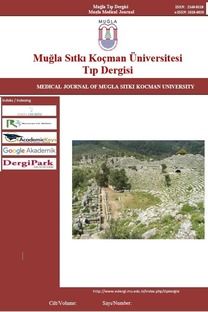İntraperitonal PEG-4000 Uygulanmasının İnce Barsak Anastomozuna Etkileri: Deneysel Çalışma
PEG-4000, Adezyon, Anastomoz, İnce Bağırsak, Yara İyileşmesi
Effects of Intraperitoneal PEG-4000 Administration on Small Bowel Anastomosis: Experimental Study
PEG-4000, Adhesion, Anastomosis, Smoll Bowel, Wound Healing,
___
- 1. Thoronton FJ, Barbul A. Healing in the gastrointestinal tract. Surg Clin North Am. 1997;77(3):549-73.
- 2. Riou JPA, Cohen JR, Johnson H. Factors nfluencing wound dehiscence. Am J Surg. 1992;163(3):324-30.
- 3. Oguma J, Ozawa S, Morikawa Y, et al. Knot-tying force during suturing and wound healing in the gastrointestinal tract. Journal of Surgical Research. 2007;140(1):129-34.
- 4. Weibel MA, Majno G. Peritoneal adhesions and their relation to abdominal surgery: A postmortem study. Am J Surg. 1973:126(3):345-53.
- 5. Thompson JN, Whawell SA. The pathogenesis and prevention of adhesion formation. Br J Surg. 1995;82(1):3-5.
- 6. Barmparas G, Branco BC, Schnüriger B, Lam L, Inaba K, Demetriades D. The incidence and risk factors of post-laparotomy adhesive small bowel obstruction. J Gastro Surg. 2010;14(10):1619-28.
- 7. Garibay-González F, Navarrete-Arellano M, Moreno-Delgado F, Salinas-Hernández EL, Rodríguez-Ayala E, Cleva-Villanueva G. Incidence of intestinal obstruction due to post-surgical adhesions in the Central Military Hospital. Associated risk factors. Rev San Militar. 2018;71(6):534-44.
- 8. Cheadle WG, Garr EE, Richardson JD. The importance of early diagnosis of small bowel obstruction. Am Surg. 1988;54(9):565-9.
- 9. Milligan DW, Raftery AT. Observations on the pathogenesis of peritoneal adhesions:A light and electron microscopical study. Br J Surg. 1974;61(4):274-80.
- 10. Buckman RF, Woods M, Sargent L. A unifying pathogenetic mechanism in the etiology of intraperitoneal adhesions. J Surg Res. 1976;20(1):1-5.
- 11. Harris ES, Morgan RF, Rodeheaver GT. Analysis of the kinetics of peritoneal adhesion formation in the rat and evaluation of potential antiadhesive agents. Surgery. 1995;117(6):663-9.
- 12. Vipond MN, Whawell SA, Thompson JN. Peritoneal fibrinolytic activity and intraabdominal adhesions. Lancet. 1990;335(8698):1120-2.
- 13. DeChemey AH, di Zerega GS. Clinical problem of inraperitoneal postsurgical adhesion formation following general surgery and the use of adhesion prevention barriers. Surg Clin North Am. 1997;77:671-88.
- 14. Cai H, Qiao L, Song K, He Y. Oxidized, regenerated cellulose adhesion barrier plus intrauterine device prevents recurrence after adhesiolysis for moderate to severe intrauterine adhesions. Journal of minimally invasive gynecology.2017;24(1):80-8.
- 15. Nagelschmidt M, Saad S. Influence of polyethyleneglycol 4000 and dextran 70 on adhesion formation in rats. J Surg Res. 1997;67(2):113-8.
- 16. Arakawa J, Timasheff SN. Mechanism of polyethyleneglycol interaction with proteins. Biochemistry. 1985;24(24):675-8.
- 17. O'Sullivan D, O'Riordain M, O'Connell RP. Peritoneal adhesion formation after lysis: Inhibition by polyethyleneglycol 4000. Br J Surg. 1991(4);78:427-9.
- 18. Punnonen R, Viinamaki O. Polyethyleneglycol 4000 in the prevention of peritoneal adhesions. Fertil Steril. 1982;38(4):491-2.
- 19. Sakarya A, Ilkgul O, Aydede H, Erhan Y. Effect of polyethylene glycol 4000 on adhesion formation following thyroid surgery in rats. Indian J Med Res. 2002;115:255-9.
- 20. Merck madde kataloğu. 1997; sayfa:1002. M807490.1000.
- 21. EBSCO&MED medline (CD), 1982-1997.
- 22. Burns JW, Skinner K, Colt MJ. A hyaluronate based gel for prevention of postsurgical adhesions: evaluation in two animal species. Fertil Steril. 1996;66(5):814-21.
- 23. Woessner JB. The determination of hidroxyproline in tissue and protein samples cotaining small proportions of this aminoacid. Arch Biochem Biophysics. 1961;93(2):440-7.
- 24. Sunar H, Uysal H, Barut G. Kolon anastomozlarının iyileşmesinde yüksek ve düşük doz metilprednisolon etkisinin 'flowcytometric DNA content analizi' hidroksiprolin, patlama basıncı ve histopatolojik değerlendirilmesi. Klinik Den Cer Der. 1995;3:110-3.
- 25. Ehrlich HP. Collagen considerations in scarring and regenerative repair. In Scarless wound healing. 2016;115-130.1a ed. New York. CRC Press.
- 26. Cronin K, Jackson DS, Dundhy JE. Changing bursting strength and collagen content of the healing colon. Surg Gynecol Obstet. 1968;126(4):747-51.
- 27. Zhao L, Zhou Y, Song C, Wang Z, Cuschieri A. Predicting burst pressure of radiofrequency-induced colorectal anastomosis by bio-impedance measurement. Physiol Meas. 2017;38(3):489-500.
- 28. Hdngstrom H, Haglund U. Postoperative decrease in suture holding capacity in laparotomy wounds and anastomoses. Acta Chir Scand. 1985;151(6):533-5.
- 29. Hawley PR. Causes and prevention of colonic anastomotic breakdown. Dis Colon Rectum. 1973;16(4):272-7.
- ISSN: 2148-8118
- Yayın Aralığı: Yılda 3 Sayı
- Başlangıç: 2014
- Yayıncı: Muğla Sıtkı Koçman Üniversitesi
Gokhan OZGUR, İlker TASCI, Serkan TAPAN, Gurkan CELEBI, Ali SELCUK, Battal ALTUN, Gurhan TASKIN, Alper SONMEZ, Bilgin Bahadir BASGOZ, Gokhan ERDEM
Lomber Sinovial Kist. Vaka Takdimi ve Literatür Gözden Geçirme
Halil İbrahim SÜNER, Aylin GÜNEŞLİ, Soner ÇİVİ, Özgür KARDEŞ, Emre DURDAĞ, Kadir TUFAN, Fazilet KAYASELÇUK
Primer Lokalize Kutanöz Amiloidoz ve Diffüz Sistemik Skleroz Birlikteliği: Olgu Sunumu
Emine Figen TARHAN, Emine KOCA
Türk Kadınlarında Cinsel Davranış: Kayseri Örneği
Şaban KARAYAĞIZ, Ertuğrul TAŞ, Zeliha SUBAŞI, Gökalp ÖNER
İntraperitonal PEG-4000 Uygulanmasının İnce Barsak Anastomozuna Etkileri: Deneysel Çalışma
Vitiligo Hastalarında Topikal Kortikosterid Kulanımının Serum IL-17 Düzeyine Etkisi
Sevim KARAKAŞ ÇELİK, Nilgün SOLAK, Tuba EDGÜNLÜ, Ümmühani ÖZEL TÜRKÇÜ
Parkinson Hastalığında Ürik Asit Seviyesinin Cinsiyet ve Hastalık Şiddeti ile İlişkisi
Capgras Belirtileri Olan Şizofreni Olgusu: Vitamin B12 Replasmanının Tedaviye Olası Katkısı
Serdar BULUT, Süheyla DOĞAN BULUT, Ali BOZKURT, Aytekin ÖZŞAHİN
